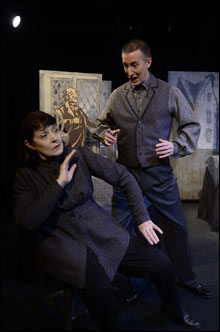
LAYERS OF ACTION M. Marguerite Mathews and Greg Gathers with their visual theatrical aids. |
Perhaps nowhere in America is the past as tangible a presence as it is in New England. In the work of one of the region's quintessential authors, Nathaniel Hawthorne, the spirit of ancestral wrongs and sufferings remains present in daily perception, like residue on the window panes. Pontine Theatre makes that spiritual presence hauntingly visual in a new adaptation of Hawthorne's The House of the Seven Gables. Created and performed by M. Marguerite Mathews and Greg Gathers, a partnership that for more than two decades has employed 19th-century stagecraft to celebrate regional culture, literature, and history, Seven Gables is an elegantly produced rendition of Hawthorne's tale of ancestral sin and redemption.Hawthorne's novel concerns the Pyncheon family of Salem, Massachusetts, and its gloomy family house haunted with misdeeds and tragedies, including a fatal accusation of wizardry. As of the mid-1800s, its occupants are only old spinster Hepzibah Pyncheon, still aristocratic but by now so poor that she's opened a store on the first floor, and her boarder, a young daguerrotypist called Holgrave, who is writing a history of the house. Incitements include the arrival of Hepzibah's young country-cousin Phoebe, and then of Hepzibah's brother Clifford, who has been serving a 30-year sentence for alleged murder. Then there's their jerk-off cousin Judge Jaffrey Pyncheon, who is obsessed with a missing document regarding the family's supposedly long-lost land in Maine, and who threatens to have Clifford committed unless he delivers information about it. Finally, while all this is happening, a romance blooms between Phoebe and the pointedly mysterious Holgrave. In other words, high melodrama, with sins of the past spooking the present.
Gathers conjures Hawthorne's Gothic atmosphere strikingly, with a palette of black and white as if age-worn into eerie grayscale. Over three modular flats he's stretched fabric printed with pale shadow-colored drawings — the title house center stage, a street scene stage right, and a tree to the left — that have been enlarged and underlaid with a several filters, like a series of scratched and cobwebbed window panes. Throughout the production, the center flat is also used as a screen for projections that help progress the narrative; characters are rendered as if in old woodcuts and slowly panned over, à la a Ken Burns documentary. The effect of these primitive images over the tainted house creates a very New England sense of the macabre, at once restrained and epic, as if layers upon layers of history compose the foundation of everyone's destinies.
Against these chilly settings, Gathers and Mathews portray the story's action by using two-dimensional, reversible cutouts of characters, moving them around three onstage tables, and by acting out the characters themselves. Their character acting is carefully measured, and they manipulate the cutouts with great care and tenderness. The reversible figures allow for some simple but lovely little blocking grace notes, as when a character crosses a platform while speaking, then turns to lean back toward the side from which she came. Gathers's and Mathews's theatrical aesthetic is of a simple, clarion traditionalism.